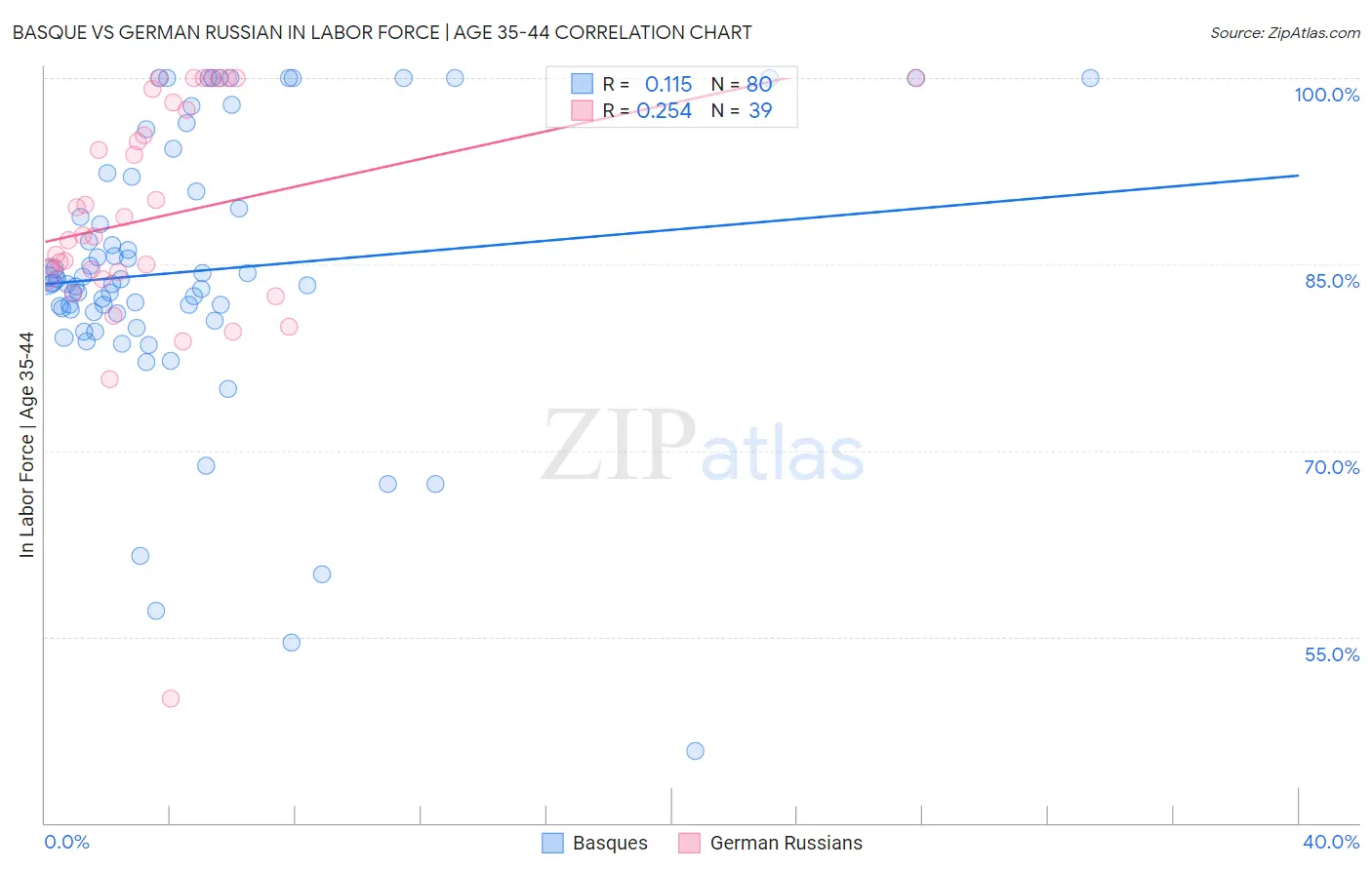Basque vs German Russian In Labor Force | Age 35-44
COMPARE
Basque
German Russian
In Labor Force | Age 35-44
In Labor Force | Age 35-44 Comparison
Basques
German Russians
83.6%
IN LABOR FORCE | AGE 35-44
0.3/ 100
METRIC RATING
257th/ 347
METRIC RANK
85.2%
IN LABOR FORCE | AGE 35-44
99.8/ 100
METRIC RATING
47th/ 347
METRIC RANK
Basque vs German Russian In Labor Force | Age 35-44 Correlation Chart
The statistical analysis conducted on geographies consisting of 165,759,018 people shows a poor positive correlation between the proportion of Basques and labor force participation rate among population between the ages 35 and 44 in the United States with a correlation coefficient (R) of 0.115 and weighted average of 83.6%. Similarly, the statistical analysis conducted on geographies consisting of 96,445,215 people shows a weak positive correlation between the proportion of German Russians and labor force participation rate among population between the ages 35 and 44 in the United States with a correlation coefficient (R) of 0.254 and weighted average of 85.2%, a difference of 1.9%.

In Labor Force | Age 35-44 Correlation Summary
| Measurement | Basque | German Russian |
| Minimum | 45.8% | 50.0% |
| Maximum | 100.0% | 100.0% |
| Range | 54.2% | 50.0% |
| Mean | 84.4% | 88.9% |
| Median | 83.5% | 87.4% |
| Interquartile 25% (IQ1) | 81.1% | 84.1% |
| Interquartile 75% (IQ3) | 91.4% | 98.0% |
| Interquartile Range (IQR) | 10.3% | 13.9% |
| Standard Deviation (Sample) | 11.1% | 9.8% |
| Standard Deviation (Population) | 11.0% | 9.7% |
Similar Demographics by In Labor Force | Age 35-44
Demographics Similar to Basques by In Labor Force | Age 35-44
In terms of in labor force | age 35-44, the demographic groups most similar to Basques are Japanese (83.6%, a difference of 0.020%), Tsimshian (83.5%, a difference of 0.020%), Immigrants from the Azores (83.6%, a difference of 0.030%), Immigrants from El Salvador (83.5%, a difference of 0.050%), and Tongan (83.6%, a difference of 0.060%).
| Demographics | Rating | Rank | In Labor Force | Age 35-44 |
| Whites/Caucasians | 0.5 /100 | #250 | Tragic 83.6% |
| Salvadorans | 0.4 /100 | #251 | Tragic 83.6% |
| Immigrants | Guyana | 0.4 /100 | #252 | Tragic 83.6% |
| Lebanese | 0.4 /100 | #253 | Tragic 83.6% |
| Tongans | 0.4 /100 | #254 | Tragic 83.6% |
| Immigrants | Azores | 0.3 /100 | #255 | Tragic 83.6% |
| Japanese | 0.3 /100 | #256 | Tragic 83.6% |
| Basques | 0.3 /100 | #257 | Tragic 83.6% |
| Tsimshian | 0.2 /100 | #258 | Tragic 83.5% |
| Immigrants | El Salvador | 0.2 /100 | #259 | Tragic 83.5% |
| Vietnamese | 0.2 /100 | #260 | Tragic 83.5% |
| Immigrants | Dominica | 0.2 /100 | #261 | Tragic 83.5% |
| Immigrants | Congo | 0.2 /100 | #262 | Tragic 83.5% |
| Iroquois | 0.2 /100 | #263 | Tragic 83.5% |
| Scotch-Irish | 0.1 /100 | #264 | Tragic 83.5% |
Demographics Similar to German Russians by In Labor Force | Age 35-44
In terms of in labor force | age 35-44, the demographic groups most similar to German Russians are Cypriot (85.2%, a difference of 0.010%), Immigrants from Hong Kong (85.2%, a difference of 0.010%), Immigrants from Eritrea (85.2%, a difference of 0.010%), Croatian (85.2%, a difference of 0.010%), and Polish (85.2%, a difference of 0.030%).
| Demographics | Rating | Rank | In Labor Force | Age 35-44 |
| Immigrants | Bulgaria | 99.8 /100 | #40 | Exceptional 85.2% |
| Immigrants | Zimbabwe | 99.8 /100 | #41 | Exceptional 85.2% |
| Macedonians | 99.8 /100 | #42 | Exceptional 85.2% |
| Poles | 99.8 /100 | #43 | Exceptional 85.2% |
| Lithuanians | 99.8 /100 | #44 | Exceptional 85.2% |
| Cypriots | 99.8 /100 | #45 | Exceptional 85.2% |
| Immigrants | Hong Kong | 99.8 /100 | #46 | Exceptional 85.2% |
| German Russians | 99.8 /100 | #47 | Exceptional 85.2% |
| Immigrants | Eritrea | 99.7 /100 | #48 | Exceptional 85.2% |
| Croatians | 99.7 /100 | #49 | Exceptional 85.2% |
| Thais | 99.7 /100 | #50 | Exceptional 85.2% |
| Immigrants | Albania | 99.7 /100 | #51 | Exceptional 85.1% |
| Immigrants | Kenya | 99.6 /100 | #52 | Exceptional 85.1% |
| Taiwanese | 99.6 /100 | #53 | Exceptional 85.1% |
| Turks | 99.5 /100 | #54 | Exceptional 85.1% |